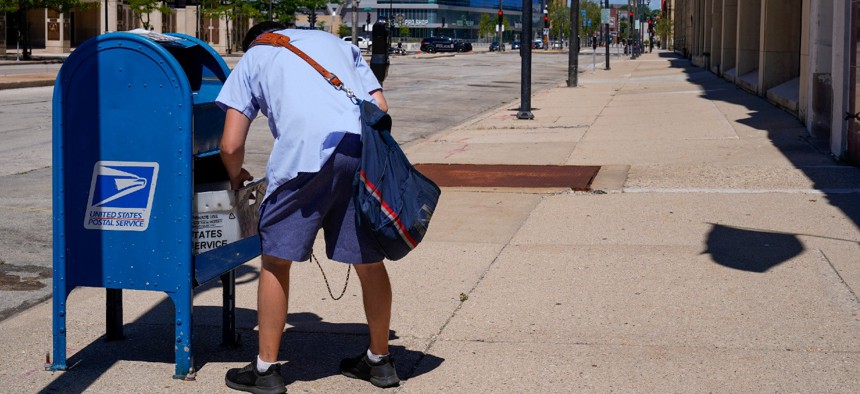
Morry Gash / AP
USPS Projects Continuing Mail Delays, Setting Targets Well Below Historical Standards
As Postmaster General Louis DeJoy seeks to implement reforms and justify changes, he once again finds himself on the hot seat.
The U.S. Postal Service is signaling that widespread mail delays prevalent in 2020 and early 2021 are the new normal, setting expectations for the remainder of the year far below historical norms.
USPS expects to deliver less than 88% of regular First-Class Mail on time for pieces slated for a two-day turnaround and less than 69% on time for those in the three-to-five day window. That would mark a decrease from 2020—already a down year—when the agency delivered 91% and 79% of mail on time, respectively. The reduced targets approved last month by the postal board of governors highlighted a significant departure from previous USPS goals, as it expected to deliver more than 95% of mail on time in all recent years.
The Postal Service will have to improve performance to meet even those lower targets, as it delivered just 86% of two-day and 58% of three-to-five day mail on time in the second quarter of fiscal 2021. Postal management announced on Thursday it had improved its overall First-Class Mail on-time delivery to 88% for the month of May. That still remains below its performance in recent years, including pandemic-affected 2020. USPS hopes to avoid delays on 93% and 85% of mail, respectively, for the remainder of fiscal 2021.
“The Postal Service will have to achieve substantial improvement in service performance across all products over the second half of the year in order to meet its end-of-fiscal-year targets,” management said in a recent filing to Congress.
Postal leadership avoided setting performance targets at the outset of the fiscal year as typically required, later saying it needed more time to assess the “ongoing and unprecedented impacts of the COVID-19 global pandemic.” Postmaster General Louis DeJoy said on Thursday there is reason for optimism going forward that mail delays will be curbed.
“While we are encouraged by the progress we have made on service performance so far this year, there is more work to be done to meet and exceed the expectations of our customers for service reliability,” DeJoy said. “The entire U.S. Postal Service is fully committed to addressing long-standing challenges head-on as we emerge from the pandemic.”
USPS has never recovered from nationwide mail delays resulting from operational changes DeJoy put into place shortly after taking office last year. While USPS worked to correct those issues and court orders eventually blocked their full implementation, delays persisted due to employee absenteeism stemming from the pandemic, unprecedented upticks in more labor-intensive package delivery and longstanding issues with the postal network.
DeJoy has suggested he is investing in modernizing that network, improving the use of real-time analytics and devoting more resources to package delivery, but he is also seeking to permanently slow down expectations for the mail. The postmaster general and other leaders have repeatedly suggested the agency’s delivery standards are no longer realistic and are seeking to extend the window for about 40% of First-Class Mail. USPS has faced significant pushback to that plan, with the American Postal Workers Union testifying this week it has been copied on nearly 80,000 comments on the mailing agency’s proposed changes. Democrats in Congress initially sought to restrict the slower delivery windows as part of its postal reform legislation, but ultimately opted to remove those provisions to win bipartisan support for the measure.
Steve Kearney, executive director of the Alliance of Nonprofit Mailers, suggested USPS’ declining targets were a tactical move directly related to the new proposed windows.
“It looks like they’re justifying their proposed slowdown of First-Class Mail with dismal expectations,” Kearney said.
DeJoy is simultaneously consolidating 18 mail processing plants, saying it will allow USPS to allocate more resources toward its growing package business. He is also raising postal prices at a much accelerated rate—about 7% for First-Class Mail—under a new authority granted to him by the Postal Regulatory Commission. Dave Partenheimer, a USPS spokesman, stressed that delivery performance has stabilized in recent months and said the agency will reinstate its 95% on-time goal if DeJoy can fully implement his vision.
While DeJoy can implement much of his plan without congressional approval, he could find himself on the hot seat before being able to see it through. As The Washington Post first reported, DeJoy is under investigation by the FBI for allegations that he illegally pressured employees at his former company to donate to Republican candidates while promising to later reimburse them through bonuses. Existing board members have shown nothing but confidence in DeJoy’s leadership, but the Senate’s confirmation of three of President Biden’s nominees has given Democrat-aligned governors a majority among the nine presidentially appointed seats.
Mark Corallo, a DeJoy spokesman, said the postmaster general will work with investigators on the matter in hopes of “swiftly resolving it.”
“Mr. DeJoy has learned that the Department of Justice is investigating campaign contributions made by employees who worked for him when he was in the private sector,” Corallo said. “He has always been scrupulous in his adherence to the campaign contribution laws and has never knowingly violated them.”
A USPS spokesman declined to comment on the probe.







